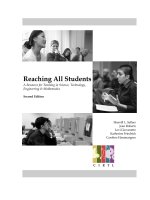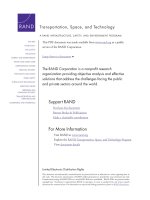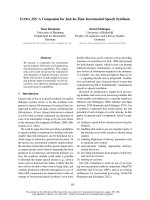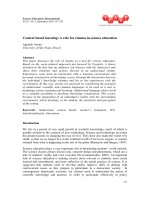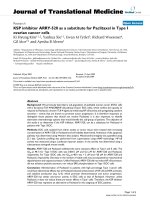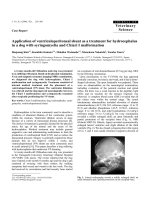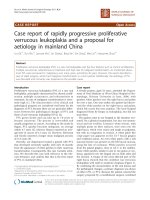- Trang chủ >>
- Mầm non - Tiểu học >>
- Lớp 5
5 4 3 a home for humans in outer space is it possible (space and technology)
Bạn đang xem bản rút gọn của tài liệu. Xem và tải ngay bản đầy đủ của tài liệu tại đây (3.98 MB, 12 trang )
Suggested levels for Guided Reading, DRA,™
Lexile,® and Reading Recovery™ are provided
in the Pearson Scott Foresman Leveling Guide.
Genre
Expository
nonfiction
Comprehension
Skills and Strategy
• Graphic Sources
• Main Idea and
Details
• Monitor and Fix Up
Space and Technology
Text Features
•
•
•
•
Captions
Charts
Table of Contents
Heads
Scott Foresman Reading Street 5.4.3
ISBN 0-328-13555-0
ì<(sk$m)=bdf fe< +^-Ä-U-Ä-U
A Home for
Humans in
Outer Space:
Is It Possible?
by Lillian Forman
Reader Response
A Home for
Humans in
Outer Space:
Is It Possible?
1. Look at the graph on page 15 showing global power
use. Which source provides the majority of the world’s
power?
2. Reread the information in “Takeoff into Space” on
pages 6 and 7. Using that information, make a time
line of space exploration like the one below. Research
additional information to add to your time line.
Event
Date
First dog in space
1957
3. Use a dictionary to find out the Greek roots for
asteroid and astronomically. How are they related?
List other words with these same roots and provide
definitions.
4. Read the information about space colonies on pages
13 and 14. Imagine you’re living on a space colony.
What would you like about it? What would you miss
about life on Earth?
by Lillian Forman
Editorial Offices: Glenview, Illinois • Parsippany, New Jersey • New York, New York
Sales Offices: Needham, Massachusetts • Duluth, Georgia • Glenview, Illinois
Coppell, Texas • Ontario, California • Mesa, Arizona
Contents
The Space Debate . . . . . . . . . . . . . . . . . . . . . . . 4
Asteroid Attack! . . . . . . . . . . . . . . . . . . . . . . . . 5
Takeoff into Space . . . . . . . . . . . . . . . . . . . . . . 6
Life on Mars? . . . . . . . . . . . . . . . . . . . . . . . . . . . 8
The International Space Station . . . . . . . . . . . . 9
Space and the Human Body . . . . . . . . . . . . . . 10
Every effort has been made to secure permission and provide appropriate credit for
photographic material. The publisher deeply regrets any omission and pledges to
correct errors called to its attention in subsequent editions.
Unless otherwise acknowledged, all photographs are the property of Scott Foresman,
a division of Pearson Education.
Photo locators denoted as follows: Top (T), Center (C), Bottom (B), Left (L), Right (R),
Background (Bkgd)
Opener: Original image courtesy of NASA/Corbis; 1 NASA; 4 ©NASA/Roger Ressmeyer/
Corbis; 5 Sanfor/Agliolo/Corbis; 7 ©Bettmann/Corbis; 8 ©Reuters/Corbis; 9 ©Reuters/
Corbis; 10 ©Jim Sugar/Corbis; 11 Original image courtesy of Buzz Aldrin/NASA/Corbis;
13 NASA; 17 Original image courtesy of NASA/Corbis
ISBN: 0-328-13555-0
Fake Gravity . . . . . . . . . . . . . . . . . . . . . . . . . . . 12
Space Colonies . . . . . . . . . . . . . . . . . . . . . . . . . 13
Other Benefits of Space Colonies . . . . . . . . . . 14
What’s Next? . . . . . . . . . . . . . . . . . . . . . . . . . . 16
Now Try This . . . . . . . . . . . . . . . . . . . . . . . . . . 18
Glossary . . . . . . . . . . . . . . . . . . . . . . . . . . . . . . 20
Copyright © Pearson Education, Inc.
All Rights Reserved. Printed in the United States of America. This publication is
protected by Copyright, and permission should be obtained from the publisher
prior to any prohibited reproduction, storage in a retrieval system, or transmission
in any form by any means, electronic, mechanical, photocopying, recording, or
likewise. For information regarding permission(s), write to: Permissions Department,
Scott Foresman, 1900 East Lake Avenue, Glenview, Illinois 60025.
2 3 4 5 6 7 8 9 10 V0G1 14 13 12 11 10 09 08 07 06 05
3
Asteroid Attack!
Asteroid Attack!
The Space Debate
When you look up at the sky at night, do you long
to visit one of the worlds sparkling above you? Or do
you feel grateful that you are safe and comfortable
here on Earth?
Some people see space travel and the search for
extraterrestrial life as a wonderful adventure, but
does this life exist? There’s only one way to find
out—by looking for it.
Other people, however, are critical of space travel.
They see it as far too dangerous and expensive. They
say the benefits of space travel are scarce, and they
argue that the money would be better spent on
improving our environments and civilizations here
on Earth.
4
Asteroids are small objects that orbit the sun in
our solar system. There are thought to be several
thousand of them, and they are anywhere from
a few meters to 200 kilometers across. Some
astronomers believe that asteroids are chunks of
cosmic matter that never formed a planet when
our solar system came into being. Some of these
asteroids come inside the orbit of Earth. What would
happen if an asteroid collided with our planet?
For one thing, you wouldn’t want to be close by
to find out. Some scientists believe that an asteroid
crashed into Earth 65 million years ago, wiping
out the dinosaurs. More recently, an asteroid came
crashing toward Siberia in 1908, but it exploded
several miles above the Earth’s surface. Even so, the
force of the explosion leveled 800 square miles of
forest. It started a fire that burned for weeks.
5
So, what should we do if an asteroid is on
a collision course with Earth? One way to save
ourselves is to deflect the asteroid before it hits us.
After scientists studied the asteroid, including what
it’s made of, its shape and its way of moving, they
would figure out the best way to knock it off its path.
Currently, scientists say that we owe it to future
generations to figure out this problem as soon as
possible. To that end, many are already trying to
figure out ways of making deep space travel both
possible and affordable.
Takeoff into Space Travel
In 1957, the former Soviet Union sent a dog into
space in a shuttle. It was the first time any living
creature had traveled outside of Earth’s atmosphere.
Not to be left behind, America got to work.
In 1958, the National Aeronautics and Space
Administration (NASA) was created, and in 1961,
President Kennedy set a goal for the decade: to send
a man to the moon and return him safely to Earth.
Many people thought it wasn’t possible. Scientists
knew otherwise.
In 1969, the first astronauts landed on the
moon as part of the Apollo 11 space mission. Neil
Armstrong said these famous words, transmitted via
radio and TV, as he set foot on the moon: “That’s
one small step for man, one giant leap for mankind.”
6
Neil Armstrong became the first human
being to walk on the moon.
The Apollo 11 mission tested the equipment
needed to provide oxygen, electricity, and warmth
to the astronauts both on the spacecraft and on the
moon. It also demonstrated the spacecraft’s ability to
withstand the six-day trip there and back.
In the following decades, scientists pursued other
important space projects. In the 1970s, 1980s, and
1990s, space engineers began to launch satellites.
Satellites are used in everyday life around the world
for many things, including satellite TV and feeding
information into global-positioning systems in cars.
Other satellites became orbiting space stations,
functioning as laboratories to study the effects of
weightlessness.
Scientists also turned their attention to the
outer planets of our solar system and the vast areas
beyond it. Satellites such as Voyager 2 flew as far as
Neptune, taking close-up photos of the planets in
our solar system.
7
Mars rover
Life on Mars?
Our neighboring planet, Mars, has long been
imagined as a place where people might live, and
many books and movies have been based on this
idea. In the 1990s and early 2000s, several NASA
projects investigated whether life has ever existed on
the red planet.
Mars is the most likely of the other planets in
our solar system to support life. It is true that its
surface temperatures can swing from very hot to
very cold, but in certain areas of the planet, perhaps
underground, some forms of life could survive.
In 2001, scientists examined a meteorite that
had fallen to Earth from Mars 13,000 years ago.
They found objects embedded in the meteorite that
appear to be bacteria, a form of life. Some scientists
argued that these “bacteria” were merely lumps of
lifeless protein that were created by stress as the
meteorite hurtled through space and crashed to
Earth. Robot explorers that were sent to Mars in
2003 have not yet found any bacteria on the Martian
surface. They found something else: evidence that
Mars has, or once had, water. Missions continue to
explore Mars today.
8
The International
Space Station
Even though no one lives on Mars, or any planet
other than Earth, people do live in space. Where?
On the International Space Station. In 1998, the
United States and Russia worked together to launch
two parts of the station into orbit. Other parts soon
followed, and the first crew arrived in 2000.
Since the Space Station was built, we’ve learned a
lot about how people can survive in space. The main
challenge is living in zero gravity. Without gravity,
things just float in the air, rather than falling to the
ground.
9
Some things we’ve learned are serious, such as
how to keep healthy. Other things are just fun, such
as figuring out that tortillas are easier to eat than
bread, because they don’t leave crumbs floating in
the air. How do astronauts clean clothes? They put
them in plastic bags with damp soap and squish
them around. Then, they dry the clothes with towels.
With no gravity, an astronaut could sleep in midair, but then he or she might bump into things in the
night. So, astronauts strap themselves down before
they go to bed at night.
Space and the Human Body
One of the most critical issues scientists are
investigating is how people can survive for long
periods in zero gravity. You know that gravity keeps
your feet on the ground. But it also keeps your body
healthy. You build muscles whenever you move,
because you are fighting against gravity.
Astronauts who go for relatively short space
flights (lasting a few weeks or months) say that they
get used to weightlessness fairly quickly. When these
astronauts return to Earth, the physical effects of
low gravity wear off after about thirty minutes, and
medical examinations usually find that they have
suffered no lasting damage from having been in
space.
10
Spending a long time in zero gravity, however,
can be very bad for your health. On Earth, the heart
works against gravity to pump blood throughout
the body. In low gravity, the heart slows down, and
after a long period spent in weightlessness, the heart
would become weak and inefficient. Bones and
muscles lose their strength in space because they no
longer have to contend with gravity. On a long space
flight, astronauts would have to take a lot of time
from work to lift weights and run on treadmills. If
they did not, their bodies would become as weak as
those of elderly people. Since human bodies work
best with gravity, could we really survive zero gravity
for a long time?
Notice how puffy
the astronaut’s
face looks. This is
because there is no
gravity to pull his
bodily fluids into his
lower body.
11
Fake Gravity
One way to deal with weightlessness is to find
a substitute for gravity. Some scientists think that
centripetal force could take the place of gravity.
An example of centripetal force is what happens
if you spin around in a circle, while holding a bucket
of water by a handle in your outstretched arms. If
you spin quickly enough, the water will not spill out
of the bucket. Why? The bucket’s force is sending it
in a straight line. At the same time, your arms are
pulling it in a circle, which means you are creating
a centripetal force. In response to your pulling, the
weight of the bucket becomes perpendicular to your
body. You can spin around without spilling a drop!
How does this matter in space? Centripetal
force can create “fake gravity.” Scientist Gerald
O’Neill designed a model of a space colony called
the Stanford Torus. Shaped like a huge doughnut,
the Torus can be set spinning around its center.
Just as the water remained in the spinning bucket,
the colonists on such a colony would remain firmly
attached to its surface but without feeling the
spinning. This enables people to walk around with
their feet on the ground, just as they do with Earth’s
gravity.
12
A cutaway of the Stanford Torus, showing the inside,
where people would live
Space Colonies
An orbiting space colony like the one O’Neill
designed would be a large and elaborate version
of the space station. The picture above shows
how one type of future space colony might
look. As you can see, the colony has vegetation
to supply oxygen and food. Solar energy would
meet an orbiting colony’s power needs.
Space colonies that travel away from our solar
system might get their power for movement as
well as for the needs of daily living from nuclear
energy. Of course, it would still take thousands
13
of centuries to get to the new planet. Yet traveling
colonies would be designed to support generations
of passengers. Each generation would work on the
problem of transferring life-support systems to the
home awaiting their descendants.
As cool as this space colony looks, its construction
is still many years away. The cost of building a space
colony is astronomically expensive.
Other Benefits of
Space Colonies
There are reasons to develop space colonies, other
than escaping disaster here on Earth. Space colonies
could, for example, be used to make money.
Experiments done in zero gravity are sometimes
easier than experiments done here on Earth. So,
astronauts specialize in experiments that take
advantage of their weightless labs. Some experiments
done on the International Space Station have
contributed to the development of vaccines for
animals, which have been commercially profitable.
Unfortunately, Earth’s atmosphere blocks much of
the sun’s energy. Solar energy isn’t very efficient or
cheap. That’s why it’s only a very small fraction of the
energy we use (see graph below).
On satellites, space plants can be set far above
such blockage. Unlike the stationary solar energy
plants on Earth, an orbiting plant would follow the
sun. This means that the amount of power it can
produce is not limited by the cycle of night and day.
Of course, transporting the materials to construct
these solar energy plants would be extremely
expensive. Some scientists say that it might be
possible to manufacture building materials from
metals mined on the moon. Because of the moon’s
low gravity, it would be relatively easy and cheap to
launch the materials from there to a plant or factory
on an orbiting colony.
Global Power Consumption, 2002
Solar Power from Space
Solar power could also be a big benefit resulting
from space stations. Solar power is power that is
harnessed from the sun’s light and heat. It’s already
in use here on Earth, converting energy for houses,
and even whole communities.
*Other includes geothermal, solar, wind, heat, etc.
Source: International Energy Agency, 2004
14
15
What’s Next?
Much practical good has already come from
attempting to solve the problems of space travel.
We use satellites every day. Experiments conducted
in low gravity labs have given us new products, such
as medicines and advanced computer chips, and the
study of the effects of weightlessness on the human
body has given us ideas on how to slow down the
aging process.
Space travel is still very expensive, and in a world
with so many problems to solve, there will always
be people who say that it’s not worth the money.
But there are questions to consider. Will an asteroid
ever hit our planet? Will space travel save us? While
there’s no way to know, scientists are working
steadily to keep people safe.
16
17
Now Try This
to Do It!
w
o
H
s
’
e
r
He
You’re in Charge:
Plan a Space Mission
Uh-oh! An asteroid is headed straight for Earth,
and you are in charge of saving your family and
friends, and heading off to find a new home in
space. Follow the steps on the next page to plan
your mission.
MATERIALS NEEDED
Destination
Time to
Travel
(at 2,485 miles
per hour)
Moon
238,855 miles
4 days
Mars
48,709,273 miles
27 months
Proxima Centauri
(the closest star)
24,792,702,900,000
miles
1,138,699 years
Source: National Aeronautics and Space Administration
18
2. Then write the following list
(use the chart on page 18 for reference):
Destination:
Distance from Earth:
Time to Travel:
3. Then, skip a line, and start a list titled
“Necessities.” Number the lines 1 through 10.
Then list ten things you will need to survive in
space. You can go back to pages 9–14 for ideas.
lined paper
blank paper
a gray pencil
colored pens or pencils
Distance
from Earth
1. Take a sheet of lined paper, and using your gray
pencil, title it. Give it a name you really like, such
as Mission Possible or Conquering Space Mission.
4. Skip another line, and start a list called, “Mission
Crewmates.” List the people you’ll be bringing
with you.
5. You have enough time to build a space station
that will house you and your family and friends.
Check out the drawing on page 13 for ideas.
Then, on the blank paper, draw your own space
station with colored pencils. Is there anything the
artist didn’t include that you would like on your
space station?
6. Share your plan and drawing with people you’ve
invited to be crewmates. Ask them if they’d like
to include anything you haven’t thought of yet
on your list of necessities, or on your plan for the
space station.
19
Glossary
Reader Response
asteroids n. small, rocky
celestial bodies.
deflect v. to turn
something off its course.
astronomically adj. so
large that we cannot
comprehend it.
extraterrestrial adj.
beyond or outside the
Earth’s atmosphere.
contend v. work hard
against difficulties.
vegetation n. plant life.
cycle n. a series of events,
such as seasons, that
occur regularly and that
return to their beginning.
1. Look at the graph on page 15 showing global power
use. Which source provides the majority of the world’s
power?
2. Reread the information in “Takeoff into Space” on
pages 6 and 7. Using that information, make a time
line of space exploration like the one below. Research
additional information to add to your time line.
Event
Date
First dog in space
1957
3. Use a dictionary to find out the Greek roots for
asteroid and astronomically. How are they related?
List other words with these same roots and provide
definitions.
4. Read the information about space colonies on pages
13 and 14. Imagine you’re living on a space colony.
What would you like about it? What would you miss
about life on Earth?
20
